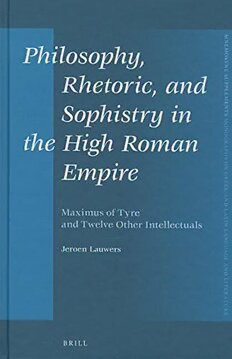
Philosophy, Rhetoric, and Sophistry in the High Roman Empire: Maximus of Tyre and Twelve Other Intellectuals PDF
Preview Philosophy, Rhetoric, and Sophistry in the High Roman Empire: Maximus of Tyre and Twelve Other Intellectuals
Philosophy,Rhetoric,andSophistryintheHighRomanEmpire Mnemosyne Supplements monographs on greek and latin language and literature ExecutiveEditor G.J.Boter(vuUniversityAmsterdam) EditorialBoard A.Chaniotis(OxfordUniversity) K.M.Coleman(HarvardUniversity) I.J.F.deJong(UniversityofAmsterdam) T.Reinhardt(OxfordUniversity) AdvisoryBoard K.A.Algra–R.J.Allan–M.A.Harder–S.Harrison C.H.M.Kroon–A.P.M.H.Lardinois–I.Sluiter–F.M.J.Waanders volume385 Thetitlespublishedinthisseriesarelistedatbrill.com/mns Philosophy, Rhetoric, and Sophistry in the High Roman Empire MaximusofTyreandTwelveOtherIntellectuals By JeroenLauwers leiden | boston LibraryofCongressCataloging-in-PublicationData Lauwers,Jeroen. Philosophy,rhetoric,andsophistryinthehighRomanEmpire:MaximusofTyreandtwelveother intellectuals/byJeroenLauwers. pagescm.–(Mnemosynesupplements:monographsonGreekandLatinlanguageandliterature,ISSN 0169-8958;VOLUME385) Includesbibliographicalreferencesandindex. ISBN978-90-04-30152-8(hardback:alk.paper)–ISBN978-90-04-30153-5(e-book) 1.Maximus,ofTyre,active2ndcentury.2.Philosophy,Ancient.3.Sophists(Greekphilosophy)4.Rhetoric, Ancient.I.Title. B588.Z7L382015 184–dc23 2015022563 Thispublicationhasbeentypesetinthemultilingual“Brill”typeface.Withover5,100characterscovering Latin,ipa,Greek,andCyrillic,thistypefaceisespeciallysuitableforuseinthehumanities.Formore information,pleaseseewww.brill.com/brill-typeface. issn0169-8958 isbn978-90-04-30152-8(hardback) isbn978-90-04-30153-5(e-book) Copyright2015byKoninklijkeBrillnv,Leiden,TheNetherlands. KoninklijkeBrillnvincorporatestheimprintsBrill,BrillHes&DeGraaf,BrillNijhoff,BrillRodopiand HoteiPublishing. Allrightsreserved.Nopartofthispublicationmaybereproduced,translated,storedinaretrievalsystem, ortransmittedinanyformorbyanymeans,electronic,mechanical,photocopying,recordingorotherwise, withoutpriorwrittenpermissionfromthepublisher. AuthorizationtophotocopyitemsforinternalorpersonaluseisgrantedbyKoninklijkeBrillnvprovided thattheappropriatefeesarepaiddirectlytoTheCopyrightClearanceCenter,222RosewoodDrive, Suite910,Danvers,ma01923,usa.Feesaresubjecttochange. Thisbookisprintedonacid-freepaper. Contents Acknowledgements vii Introduction 1 ScholarlyReception 3 FromtheCollectivetotheIndividual 6 FromMacroleveltoMicrolevel 11 WhyMaximus? 12 1 Philosophy,Rhetoric,andSophistryintheRomanEmpire 15 1 TheTraditionalConflict:AShortOverview 16 2 Greco-RomanImperialCulture 20 3 AFunctionalistApproach 38 4 IndividualAuthors 40 2 ThedialexeisofMaximusofTyre 125 1 ReadingMaximus’dialexeis 125 2 CommunicationandPedagogy 136 3 Sophistry 166 4 Rhetoric 175 5 Philosophy 201 6 PurposeandMeaning 235 7 AnalysisofIndividualdialexeis 269 Conclusion 290 Bibliography 295 IndexLocorum 321 IndexofPersonsandConcepts 328 Acknowledgements Overthepastfewyears,anumberofpeopleandinstitutionshavehelpedme completethismonograph.Firstofall,mygeneroussupervisorandcolleague LucVanderStocktdeservesaninfinitenumberofthanksforhiscontinuous encouragements and for his critical eye, which studied several previous ver- sionsofthismanuscript.WarmregardsalsogoouttomycosupervisorMichael Trapp,whosegreatgenerosityandknowledgeaboutMaximusandhisculture have proven invaluable for the eventual argument in this book. I have also greatly benefited from the feedback of Geert Roskam, Jan Opsomer, Ortwin deGraef,andThomasSchmitz,whosecriticalyetencouragingreadingshave greatly increased the quality of this contribution. The same can be said of Mnemosyne’sanonymousreviewer,whopointedoutseveralareasforimprove- ment.NeedlesstosaythatIstilltakefullresponsibilityforanyremainingover- sightsorerrorsinthismanuscript. Otherpeoplewhohavedefinitelyhelpedmeagreatdealinthewritingpro- cess, maybe even without them knowing, include Judith Mossman, Katerina Oikonomopoulou, Michiel Meeusen, Bram Demulder, Thomas Schampaert, Tom Deneire, Dries De Crom, Martin Korenjak, Chiara Thumiger, Tim Whit- marsh,Heinz-GüntherNesselrath,MiriamLeonard,MaartenDePourcq,Ewen Bowie,andLuciaAthanassaki.SpecialthanksgoouttoChristopherRansom, who went through the entire manuscript in order to correct all unidiomatic andfaultyexpressions. Many friends and colleagues, both from the department of classics at the UniversityofLeuvenandfromthedepartmentofliterarystudies,haveeachin theirownwaycontributedtotheprojectthatresultedinthismonograph.Their variousinitiativesandeffortshavegreatlybeenappreciated. Theresearchthatproducedthisvolumewouldnothavebeenpossiblewith- outthesupportoftheResearchFoundation—Flanders(fwo)andtheUniver- sityofLeuven.TheformerinstitutionalsosupportedascholarlystayatKing’s CollegeLondon,whichwashighlydesirableifnotnecessaryforthedevelop- mentoftheargumentofthisbook.Thefinalstagesofthewritingprocesstook placeattheinspiringlibraryoftheFreieUniversitätBerlin,forwhichIthank Almut-BarbaraRengerandtheJuniorMobilityAllowanceoftheUniversityof Leuven. Last but not least, I wish to thank my parents, my brother Freek, my wife Ann,andmysonMagnus,towhomIdedicatethisbook. Introduction IsMaximusofTyre,theImperialGreekauthorof41orationsaboutphilosoph- icaltopics,toberegardedasaphilosopher,arhetor,orasophist?Thisisthe primaryquestionregardingwhichtheauthorofthisstudyundertookhisdoc- toral project, of which this book is the final result. It is, all in all, a straight- forwardquestion,buttheanswerprovestobealotmorecomplicated,asthe mainscholarlyjudgementsabouttheTyriansofartendtobemoreindicative ofthesescholars’owninterpretativeassumptionsthanofthedynamicintellec- tualbackgroundofImperialliteratureandphilosophy.Bymeansofadetailed studyofMaximus’dialexeisandimportantconcurrentvoices,thisbookpro- poses to resolve this scholarly problem in a fashion that is more historically accurate. For our answers, Maximus’ life and career are sources of information upon which we can hardly rely. Unlike many rhetoricians and philosophers from theperiodoftheso-called‘SecondSophistic’,MaximusofTyre,thehistorical authorofthedialexeis,isalmostentirelyunknowntous.Moreover,asaresult oftheuncertaintyabouttheadequatenessofoursources,mostelementsofthe littleinformationthatwedopossesscanbedoubtedaswell.Consequently,the statusofMaximus’ownautobiographicalaccounts,whicharealreadynotvery numeroustobeginwith,isoftenhardtoverify. A first problem arises when we confront the data of our two most impor- tantsources,viz.theChronicleofEusebiusofCaesareaandtheSuda.1Accord- ing to the former, Maximus of Tyre ‘came to prominence’ around the 232nd Olympiad,whichcorrespondstotheperiodof149to153ad.Thiswouldimply thatMaximus’floruitwas,oratleaststarted,duringthereignofAntoninusPius (138–161).However,scholarlyresearchhasevidencedthatEusebius’accountis probablyfallacious.2TheSuda,ontheotherhand,whichtookitsinformation from the Onomatologos of Hesychius, situates Maximus a couple of decades 1 Suda,s.v.Μάξιμος,Τύριος. 2 Eusebius’sourcesdonotgiveanyimpressionofbeinghistoricallyaccurate.Jerome’sversion pairsMaximuswithArrian,whocomesmuchearlier.SyncellusconfusesMaximusTyrius with the proconsul of Africa Claudius Maximus, who functioned as a judge in the trial ofApuleius’Apology.TheArmeniantranslationmakesbothmistakestogether,suggesting moreoverthatMaximus(togetherwithArrian)wasateacherofMarcusAurelius.Wecan stronglydoubt,therefore,whetherEusebius’accountitselfwasunambiguouslycorrect.See Trapp(1997a),xiin.4. © koninklijkebrillnv,leiden,2015 | doi:10.1163/9789004301535_002
